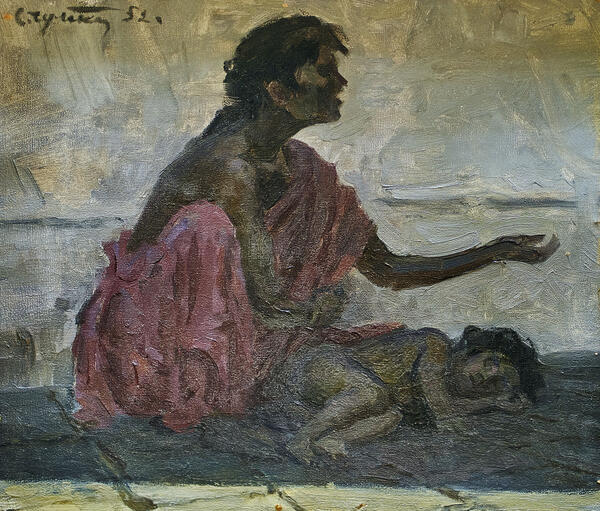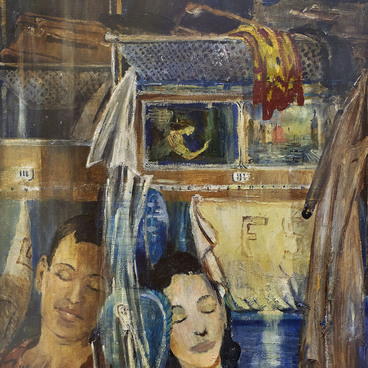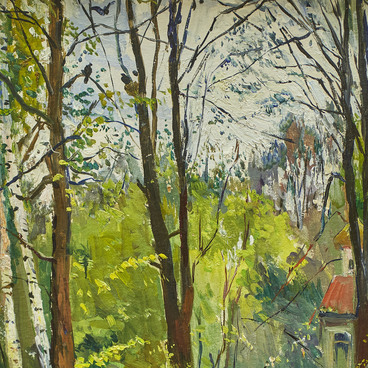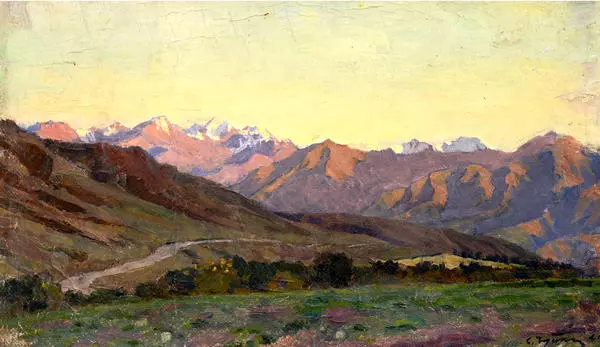‘On Calcutta street’ from the collection of the Valuy Museum of History and Art was created by the Soviet painter, People’s Artist of the USSR, laureate of two Stalin Prizes, Full Member of the USSR Academy of Arts, Semyon Chuikov.
The artist was born in Kyrgyzstan in 1902. From 1918 to 1919, he studied at the Teachers' Seminary in Verny, and then at the Art school in Tashkent. From 1924 to 1930, Semyon Chuikov lived in Moscow, where he studied at the VKhUTEMAS (Higher art and technical workshops) in the workshop of the avant-garde artist Robert Falk.
Chuikov is known for his genre and thematic paintings about the people and nature of Kyrgyzstan and India. In the 1950s and 1960s, he traveled a lot worldwide: India, Italy, France, Greece, Bulgaria. During these trips, Chuikov brought extensive artistic material in the form of various sketches, pencil sketches, on which he created vivid images of these countries and rare landscapes.
Semyon Chuikov’s works are characterized by plastic clarity, rigor, and simplicity of composition. He always attached great importance to the subtle and emotionally expressive development of color relations, a vivid sense of life’s original truth.
Chuikov visited India three times. What he saw over there formed the basis of his works. In faraway India, Semyon Chuikov saw not lush exotics, but the eyes of “untouchables” — ordinary people of this “Wonderland.”
Chuikov made a sketch “On Calcutta street” during his first trip to India in 1952. The painting is a paired portrait of poor people from the street: a woman and a child where the master sought to convey the psychological content of the theme of caste division of people and their tragic fate. The predominance of gray and cold shades in the picture creates the most vivid sense of anxiety in the audience.
Contemporaries called this series of paintings by Chuikov “Indian Suite.” In 1967, the artist was awarded the Jawaharlal Nehru prize, by the first Prime Minister of the country, for a series of Indian paintings and strengthening Indian-Soviet friendship. The award was presented for outstanding contribution to promoting international understanding, goodwill, and friendship among the world’s peoples.
The artist was born in Kyrgyzstan in 1902. From 1918 to 1919, he studied at the Teachers' Seminary in Verny, and then at the Art school in Tashkent. From 1924 to 1930, Semyon Chuikov lived in Moscow, where he studied at the VKhUTEMAS (Higher art and technical workshops) in the workshop of the avant-garde artist Robert Falk.
Chuikov is known for his genre and thematic paintings about the people and nature of Kyrgyzstan and India. In the 1950s and 1960s, he traveled a lot worldwide: India, Italy, France, Greece, Bulgaria. During these trips, Chuikov brought extensive artistic material in the form of various sketches, pencil sketches, on which he created vivid images of these countries and rare landscapes.
Semyon Chuikov’s works are characterized by plastic clarity, rigor, and simplicity of composition. He always attached great importance to the subtle and emotionally expressive development of color relations, a vivid sense of life’s original truth.
Chuikov visited India three times. What he saw over there formed the basis of his works. In faraway India, Semyon Chuikov saw not lush exotics, but the eyes of “untouchables” — ordinary people of this “Wonderland.”
Chuikov made a sketch “On Calcutta street” during his first trip to India in 1952. The painting is a paired portrait of poor people from the street: a woman and a child where the master sought to convey the psychological content of the theme of caste division of people and their tragic fate. The predominance of gray and cold shades in the picture creates the most vivid sense of anxiety in the audience.
Contemporaries called this series of paintings by Chuikov “Indian Suite.” In 1967, the artist was awarded the Jawaharlal Nehru prize, by the first Prime Minister of the country, for a series of Indian paintings and strengthening Indian-Soviet friendship. The award was presented for outstanding contribution to promoting international understanding, goodwill, and friendship among the world’s peoples.




